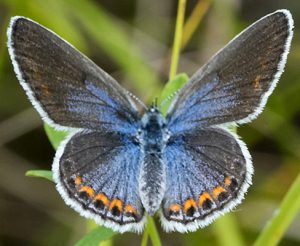Session planned at Hartman Creek
Wisconsin has more Karner blue butterflies than any other place in the world and volunteers can attend a training session to help collect information about this endangered butterfly and its habitat.
One of the sessions will be held from 10 a.m. to noon Saturday, June 16, at Hartman Creek State Park near Waupaca.
“Our goal is to train volunteers to be able to identify Karner blue butterflies so they can help us collect information from the state as a whole,” said Chelsea Gunther, coordinator of the state Department of Natural Resources’ Karner blue butterfly recovery effort.
 “We’ve only been able to survey the largest known occupied sites over the years, so expanding our capacity to collect information on areas where we’re not sure if Karners are still present will improve our data and give us a better statewide picture,” she said.
“We’ve only been able to survey the largest known occupied sites over the years, so expanding our capacity to collect information on areas where we’re not sure if Karners are still present will improve our data and give us a better statewide picture,” she said.
Anyone interested in attending the session is required to register by Thursday, June 14. The sign-up link is listed under the “volunteer” tab on the Karner blue butterfly page of the DNR’s website.
Karner caterpillars eat only wild lupine, a plant found mostly in oak and pine barrens habitats, which have been lost in Wisconsin and elsewhere.
The volunteer training is part of the DNR’s Karner blue monitoring program, which has been revamped this year, and is one of four main efforts underway to protect and restore Karners and their habitat.
The progress of these efforts has helped turn Wisconsin’s Karner blue butterfly population into the world’s largest and a stronghold of efforts to restore the species to its former range, according to Owen Boyle, species management section chief for DNR’s the Natural Heritage Conservation program.
The DNR is working to maintain and restore Karner blue butterfly habitat and recent work has occurred on state, county and private lands.
Between 2016 and the end of 2018 alone, the DNR expects to have restored more than 1,100 additional acres of habitat on these sites through mowing; removing invasive species; planting lupine and native nectar species; and conducting prescribed burns.
The DNR and 51 other partners are part of a statewide Habitat Conservation Plan, established in 1999, that allows certain activities such as roadside maintenance and timber harvests in Karner blue habitat, but assures those activities are carried out in ways that conserve and restore the butterfly and its habitat, including waiting to mow until after the butterflies have completed their annual flights.
A second partnership effort, the federal Partners for Fish and Wildlife, provides private landowners with technical and financial incentives to plant and maintain the right plants in the butterfly’s range.
